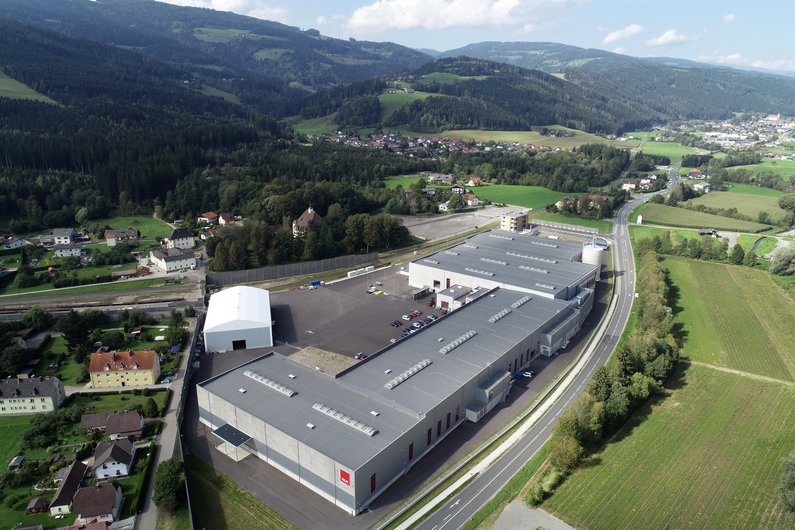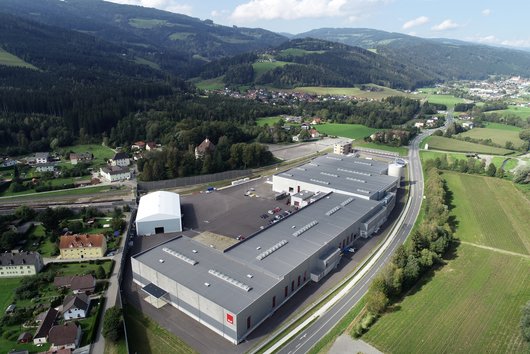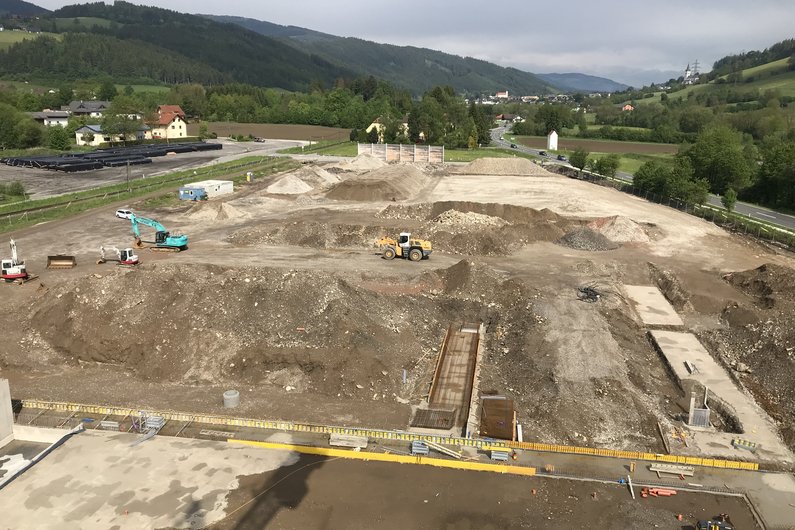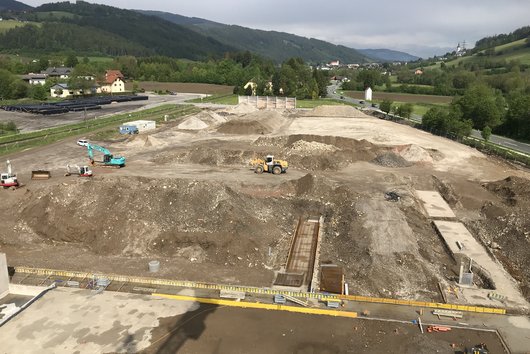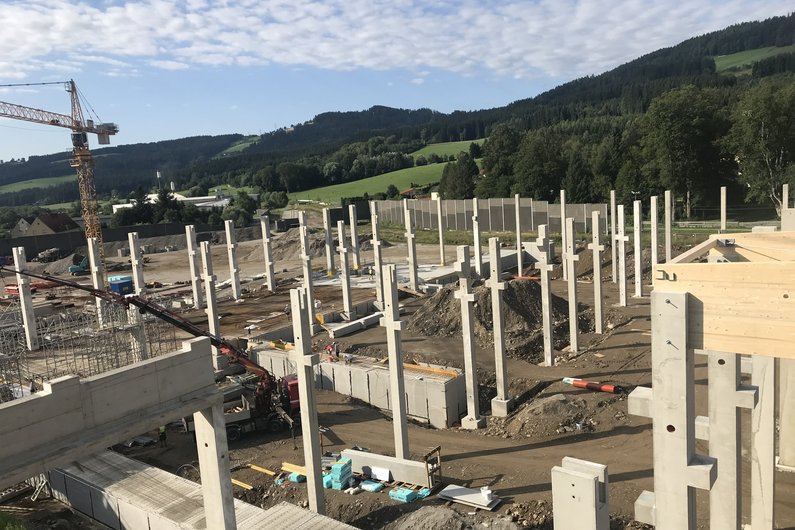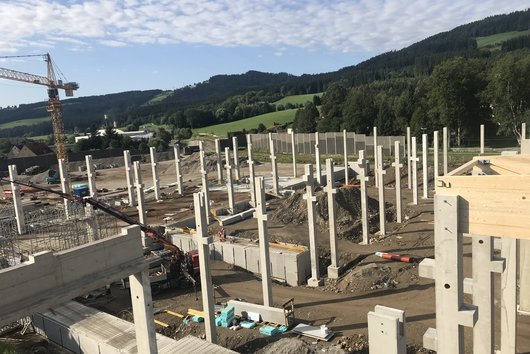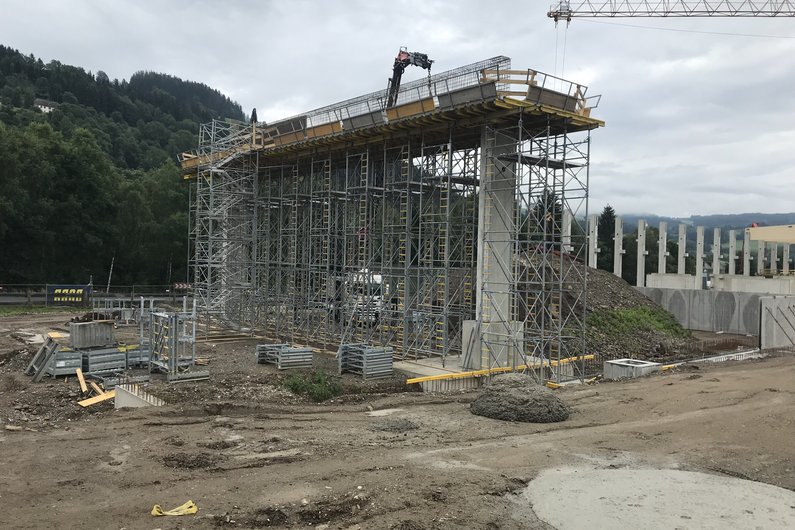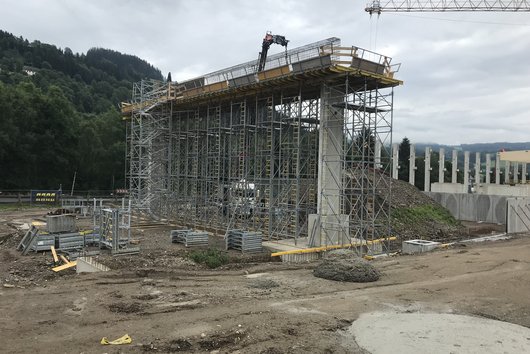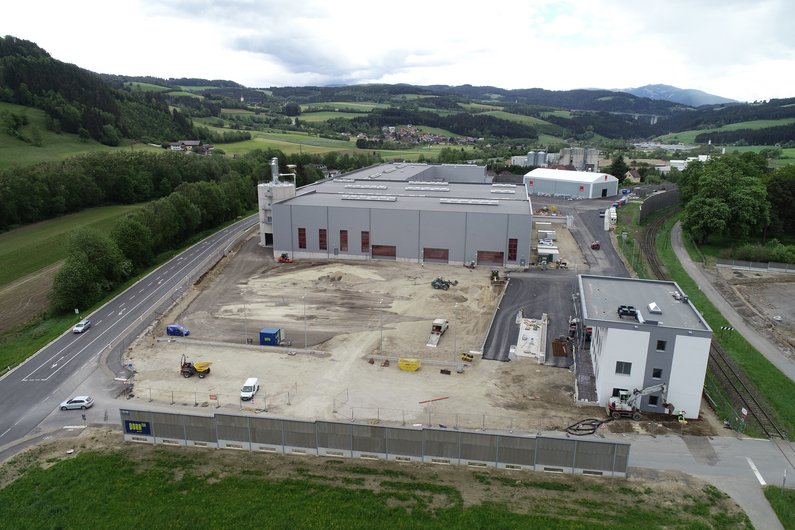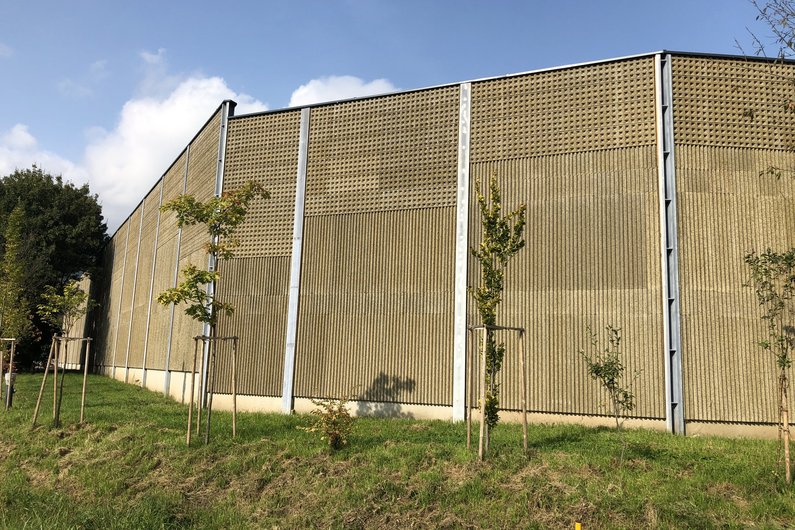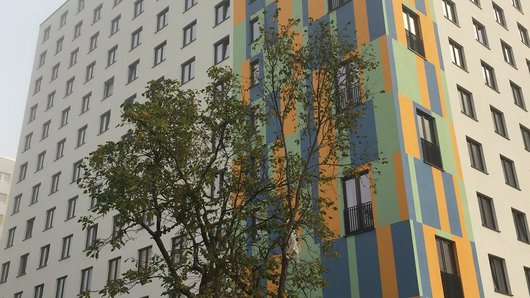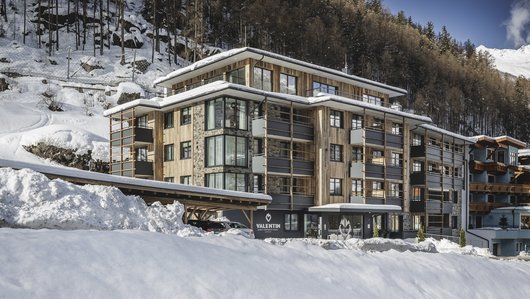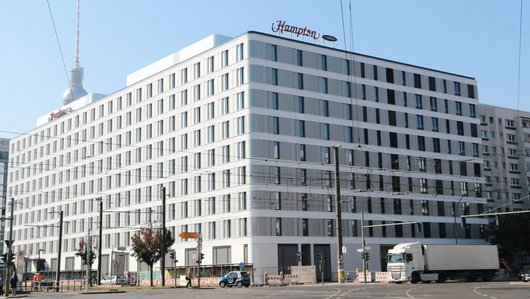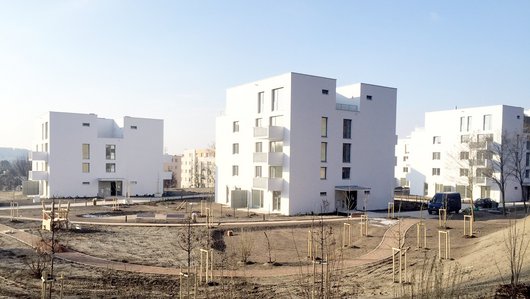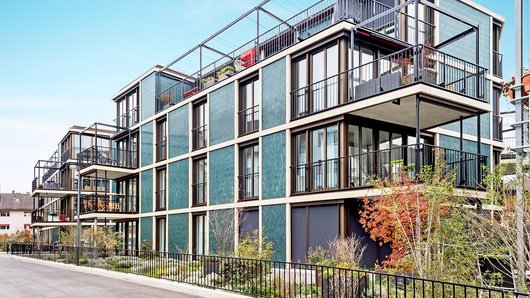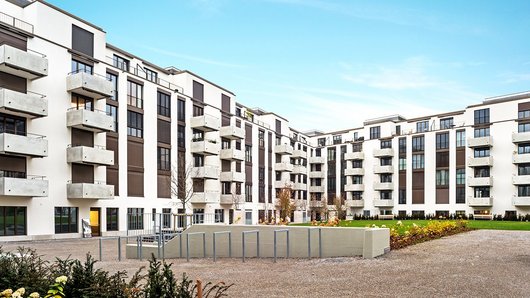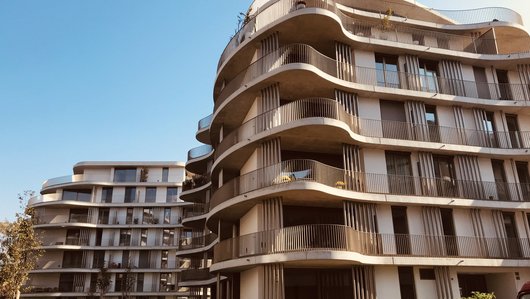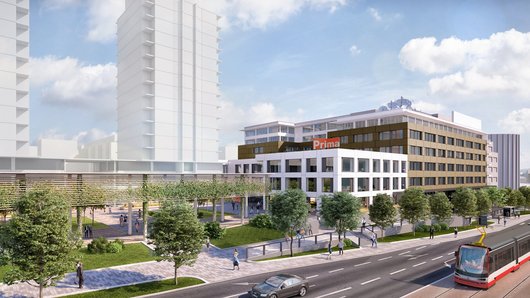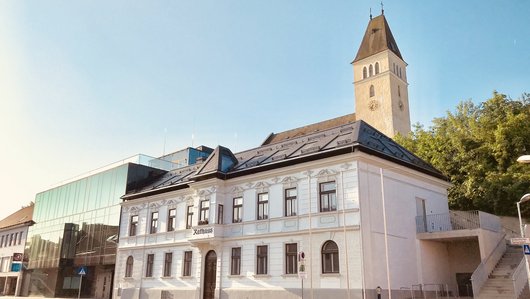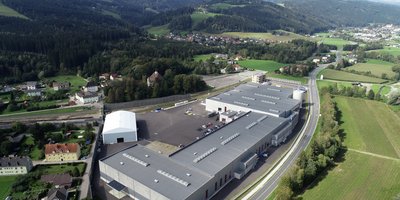
The KLH Wiesenau plant
PORR has built an entirely new production facility for KLH Massivholz Wiesenau GmbH in Bad St. Leonhard, Carinthia, in just 14 months.
Several production halls, an office building, comprehensive outdoor facilities including noise protection walls and a flood barrier: PORR was tasked with a tight schedule for the new KLH production facility, so we relied on the latest technology from the ground up – the earthworks. A 3D model provided the basis for all the logistics.
-
EmployerKLH Massivholz Wiesenau GmbH
-
ContractorPORR Bau GmbH - NL Kärnten
-
ArchitectBM Hermann Joham
-
Order typeBaumeisterleistungen
-
Project typeIndustrial construction
-
Project scopeConstruction of several production halls and an office building incl. all outdoor facilities
-
Order volumeEUR 9m
-
Construction start04/2019
-
Construction end06/2020
Overview
In the spring of 2019, PORR was awarded the contract for the construction of a new production facility for KLH Massivholz Wiesenau GmbH in Bad St. Leonhard, Carinthia. The contract includes several production halls, an office building and extensive outdoor facilities including noise protection walls and a flood barrier. Since its completion in June 2020, the new plant has been producing wooden panels made of CLT, or cross-laminated timber. These are layers of spruce lumber stacked on top of each other at right angles and glued together. The resulting panels can be used to make wall or ceiling elements. When operating at full capacity, the plant in Wiesenau employs around 100 people with an annual production output of around 150,000m³ of cross-laminated timber.
Earthworks with a 3D model
The team began with the earthworks straight after the groundbreaking ceremony in April 2019. PORR worked with a surveying office to create a virtual 3D model in order to be able to process the earth masses as efficiently as possible. The model allowed the team to compare the existing site with the finished project site, providing a basis for all the logistics. On this basis, PORR moved more than 50,000 m³ of soil on the approximately 60,000m² construction site. The team then processed a considerable part of the excavated soil for other jobs at the site – as rolling for the seepage packings, for example, or as frost wall materials.


Due to their high dead load, the 23 m long and 2.8 m high concrete girders could not be delivered as prefabricated parts as planned, but had to be produced as in-situ concrete girders at a height of 7 m.
Saving time thanks to prefabricated components
Once the subgrade had been prepared, PORR began the extensive concrete works. A basement was added below part of the hall area to create space for a sprinkler basin, an emergency escape tunnel and plant rooms. Originally, this was to have involved the use of in-situ concrete walls. During the work preparation phase, however, the team in coordination with the planners and structural engineers, opted to use prefabricated components instead. This significantly reduced the amount of work and construction time. While work on the basement was underway, PORR also erected the supporting structure for the roof and façade at the other end of the hall: 144 prefabricated columns were positioned in prefabricated footings. This had to be done as accurately as possible, because the attached brackets later had to serve as support points for the fully automatic indoor cranes. The team then mounted prefabricated panels on the columns, and footings. These form the plinth for the halls.
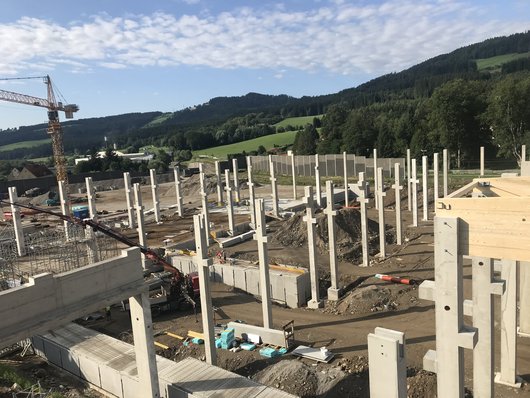

The concrete girders, which were up to 23 m long and 2.8 m high, also proved to be a real challenge. Their high dead load meant that they could not be delivered by the local precast factories as planned, but had to be constructed as in-situ concrete girders at a height of 7 metres. The largest reinforced concrete girder weighs 125 tonnes. The next important milestone was the completion of the hall floors in preparation for the subsequent fit-out and assembly of the production machines. Precise coordination of the individual sub-trades was necessary to ensure that the monolithic floor slabs were produced on time. Concreting sections of between 1,000 m² and 2,000 m² per week, depending on the floor plan and paving components, proved to be an effective solution. By this point, the roof and the façade had already been erected. This enabled PORR to complete 20,000 m² of concrete surfaces in just under three months, and without having to worry about the weather.
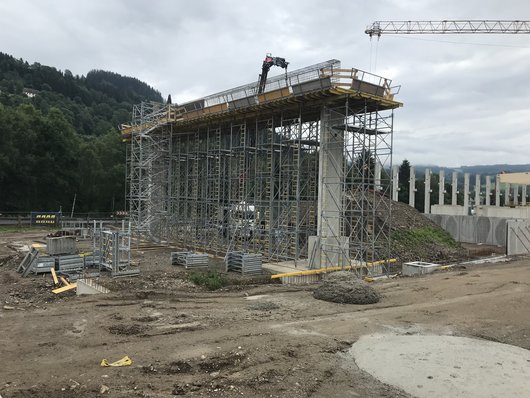

Working on the outdoor facilities
Nach dem Abschluss der Hochbauarbeiten hat die PORR für die Außenanlagen eine 30.000 m² große Asphaltfläche errichtet. Wieder war die richtige Wahl der Asphaltabschnitte entscheidend für eine erfolgreiche Umsetzung. Mehrere hundert Lkw-Stunden waren notwendig, um die rund 10.000 t Asphaltmischgut zum Einbauort zu transportieren. Die Zulieferer der Ausbaugewerke mussten jederzeit Zugang zur Halle haben. Das machte die Koordination der Asphaltierung sowie die Abstimmung mit dem Auftraggeber und der örtlichen Bauaufsicht besonders anspruchsvoll.
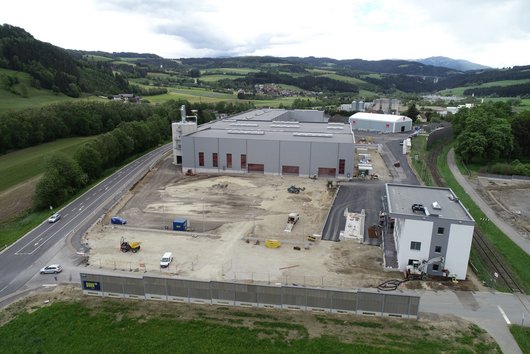

The extensive outdoor facilities also included noise protection walls up to 12 m high. They were designed to enclose the construction area and a filtering area adjacent to the hall. The team rammed steel pipes into the ground and excavated the upper part with an earth drill. After that, they were able to place steel girders in the pipes and concrete them in place. These were later to form the load-bearing elements of the noise protection walls. Together with a subcontractor and the planner, PORR modified the finished surfaces to match the existing walls. The scope of performance also included a 21 m-high reinforced concrete silo, a 310 m-long flood barrier made of prefabricated components, a fire water extraction point, a main office, a workshop office and a tent hall.
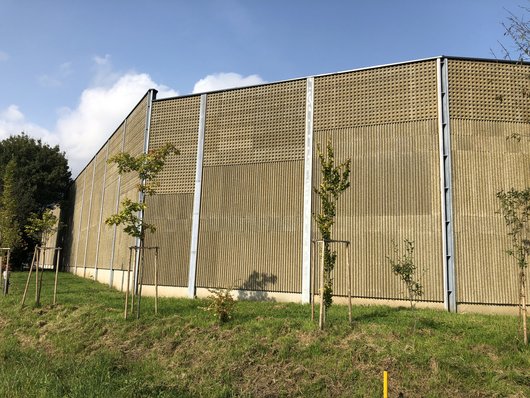

On-site safety was our top priority. This allowed us to complete the project safely and on time despite high deadline pressure and considerable logistical challenges.
Focus on workplace safety
Throughout the project, the safety of everyone involved was a top priority. The proposed safety measures were presented to the responsible labour inspectorate before the construction work began, to allow for discussion of possible improvements. Safety walks and meetings with the site coordinator were part of the weekly routine. This enabled the team to complete the works safely, despite high deadline pressure and the presence of almost 100 workers on the site at peak hours.
Conclusion
The construction of the new production facility in Wiesenau impressively demonstrated that PORR is the perfect partner for demanding projects with tight schedules. Thanks to excellent advance planning, perfect logistics and efficient coordination with the subcontractors, the project was handed over to the client on time despite the many challenges involved.
Technical data
-
Asphaltapprox. 30,000 m²
-
Concreteapprox. 15,000 m³
-
Noise protection wallsapprox. 1,900 m²
-
Earthworksapprox. 50,000 m³
-
Monolithic concrete slabapprox. 20,000 m²

